Table of Contents
<!-- Template Revision 1.65 (HTML comments will be not displayed in the document, no need to remove them. For Template/Skeleton changes, increase Template Revision number. So we can check faster, if the TRM style is up to date). --> |
<!-- General Notes: If some section is CPLD firmware dependent, make a note and if available link to the CPLD firmware description. It's in the TE shop download area in the corresponding module -> revision -> firmware folder. --> |
<!-- General Notes: Designate all graphics and pictures with a number and a description. For example "Figure 1: TE07xx-xx Block Diagram" or "Table 1: Initial delivery state". "Figure x" and "Table x" have to be formatted to bold. --> |
<!-- Download Link: Go to Base Folder of the Module or Carrier, for example : https://shop.trenz-electronic.de/en/Download/?path=Trenz_Electronic/TE0712 Use english URL "../en/.. --> |
Download PDF version of this document. |
Table of Contents |
<!-- Wiki Link: Go to Base Folder of the Module or Carrier, for example : https://wiki.trenz-electronic.de/display/PD/TE0712 --> |
Refer to https://wiki.trenz-electronic.de/display/PD/TEM0001 for the current online version of this manual and other available documentation. |
The Trenz Electronic TEM0001 is a low cost small-sized FPGA module integrating a Microsemi SmartFusion2 FPGA SoC and 8 MByte Flash memory for configuration and operation.
Microsemi SmartFusion2 SoC FPGA
8 MByte QSPI Flash memory
2x 14-pin headers (2,54 mm pitch) providing 23 I/O
9 user LEDs
Additional assembly options are available for cost or performance optimization upon request.
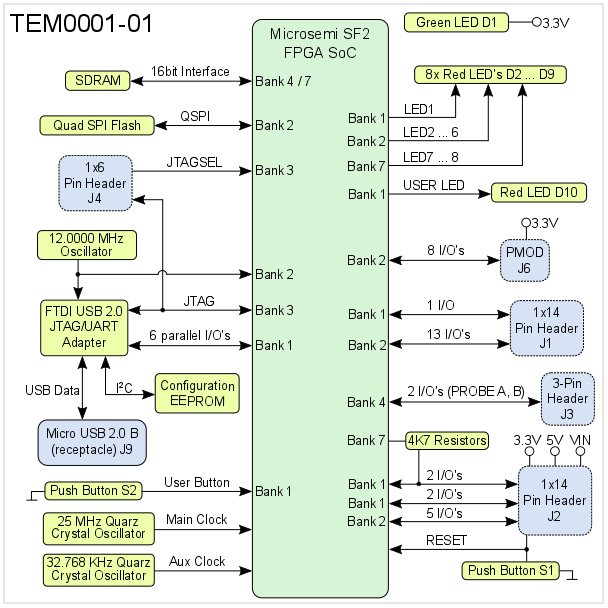
Figure 1: TEM0001-01 block diagram
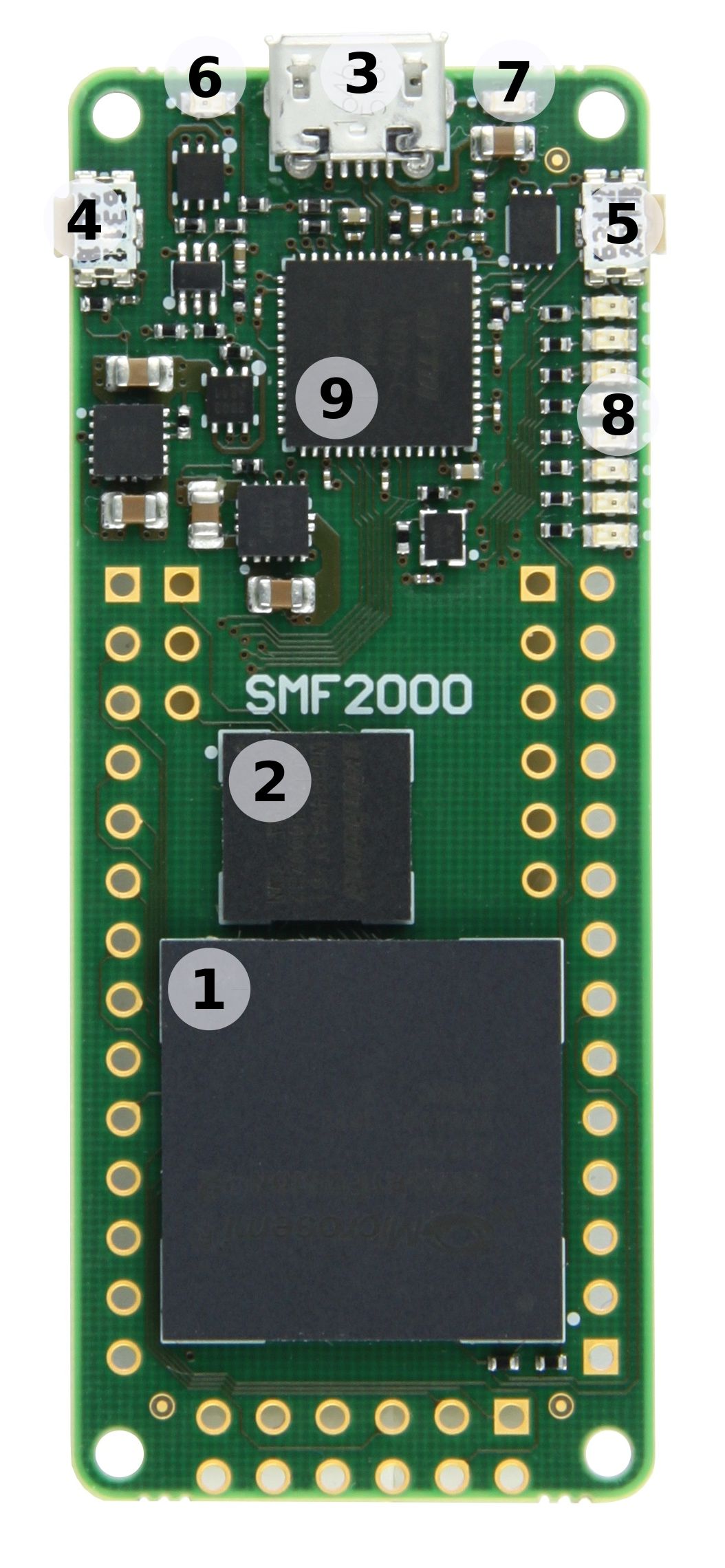
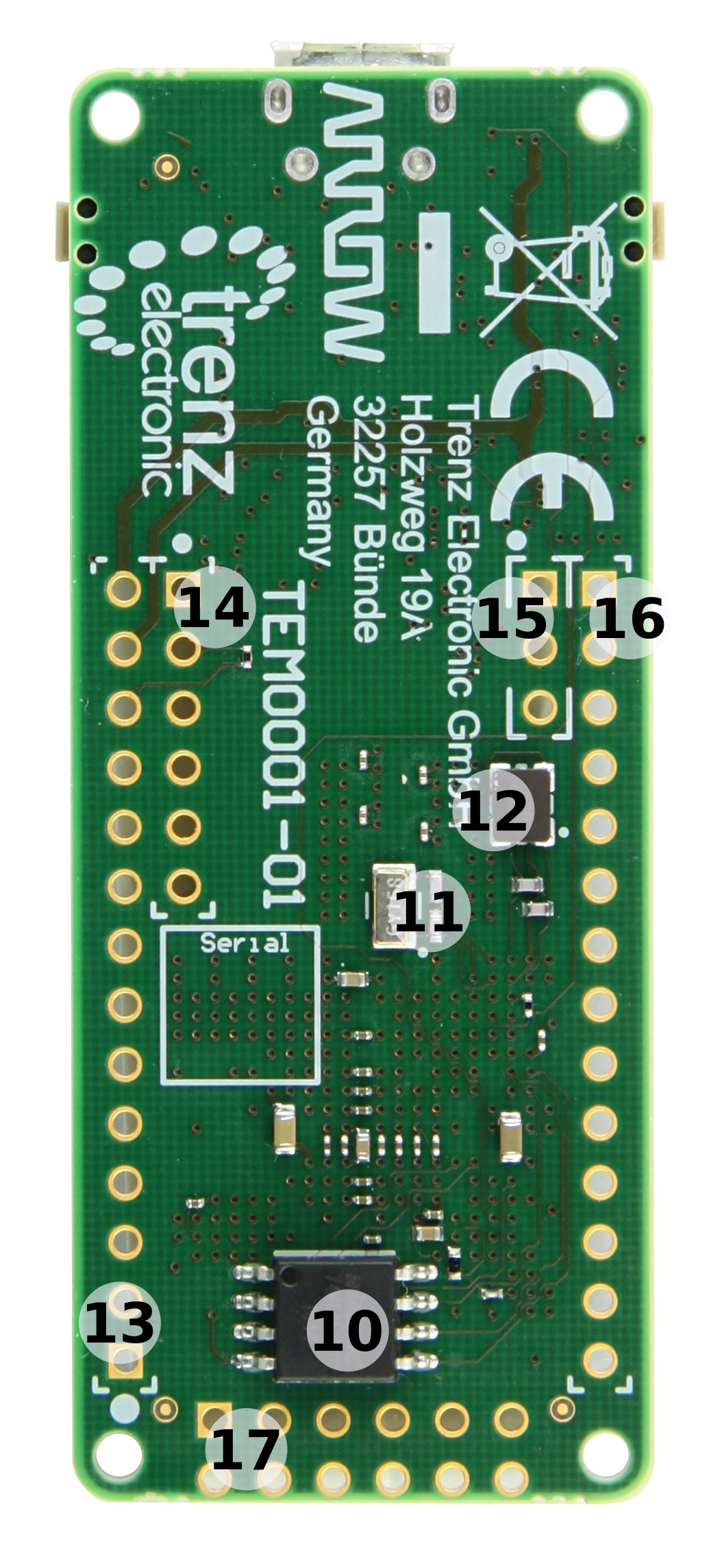
Figure 2: TEM0001-01 FPGA module
Storage device name | Content | Notes |
|---|---|---|
SPI Flash OTP area | empty | - |
| SPI Flash | empty | - |
| FTDI EEPROM, U9 | Programmed | FlashPro identification, should not be changed by customer |
Table 1: Initial delivery state of programmable devices on the module
There is are no bootmode selection Microchip SmartFusion2 SoC boots always from internal configuration flash, optionally software code for the Cortex-M or soft CPU can be placed to eNVM.
I/O signals of the FPGA SoC's I/O banks connected to the board's pin headers and connectors:
| Bank | Connector Designator | I/O Signal Count | Bank Voltage | Notes |
|---|---|---|---|---|
| 1 | J1 | 1 I/O's | 3.3V | - |
| 1 | J2 | 4 I/O's | 3.3V | 2 I/O's of bank 1 can be pulled-up to 3.3V (4K7 resistors) with 2 I/O's of Bank 7 or pins can be shared. |
| 2 | J1 | 13 I/O's | 3.3V | - |
| 2 | J2 | 5 I/O's | 3.3V | - |
| 2 | J6 | 8 /O's | 3.3V | Pmod Connector. |
| 3 | J4 | 5 I/O's | 3.3V | JTAG interface. |
| 4 | J3 | 2 I/O's | 3.3V | I/O's (PROBE A, B) are dedicated to live probes. |
| 7 | J2 | 2 I/O's | 3.3V | Those 2 I/O's are dedicated to pull-up 2 I/O's of bank 1 or pins can be shared. |
Table 2: General overview of single ended I/O signals connected to pin headers and connectors
| Bank | VCCIO | I/O's Count | Available on Connectors | Notes |
|---|---|---|---|---|
| 1 | 3.3V | 14 | 5 | 6 I/O's connected to FTDI chip, 1 I/O used for user button S2, 2 I/O's connected to red user LEDs D2 and D10. |
| 2 | 3.3V | 37 | 26 | 6 I/O's user for QSPI Flash, 5 I/O's connected to red user LEDs D3 ... D7. |
| 3 | 3.3V | 5 | 5 | Bank 3 is dedicated to JTAG interface. |
| 4 | 3.3V | 24 | 2 | 2 I/O's are dedicated to live probes, all other I/O's are used as memory interface. |
| 7 | 3.3V | 22 | 2 | 2 I/O's available on header J2, 2 I/O's connected to red user LEDs D8 and D9, all other I/O's are used as memory interface. |
Table 3: General overview of FPGA I/O banks
JTAG access to the FPGA SoC device U5 is provided through Micro USB2 B connector J9. The JTAG interface is implemented with FTDI FT2232H USB2 to JTAG/UART bridge IC U3.
Optionally 1x6 male pin header J4 can be fitted on board for access to the JTAG interface on board. The pin assignment of header J4 is shown on table below:
| JTAG Signal | Pin on Header J4 | Note |
|---|---|---|
| TCK | 3 | - |
| TDI | 5 | - |
| TDO | 4 | - |
| TMS | 6 | - |
| JTAGSEL | 2 | can be left open for normal operation |
Table 4: optional JTAG header
The QSPI interface of the FPGA device is routed to and used by the on-module QSPI flash IC U1:
| SD IO Signal Schematic Name | FPGA I/O | Flash IC U1 Pin | Note |
|---|---|---|---|
| F_CS | Bank 2, pin K15 | 1 | QSPI chip select |
| F_CLK | Bank 2, pin P18 | 6 | QSPI clock |
| F_DI | Bank 2, pin P19 | 5 | QSPI data |
| F_DO | Bank 2, pin K16 | 2 | QSPI data |
| F_D2 | Bank 2, pin J18 | 3 | QSPI data |
| F_D3 | Bank 2, pin N19 | 7 | QSPI data |
Table 5: QSPI interface signals
Note: On-board SPI Flash is connected to regular FPGA I/O pins, access to it is only possible when using custom SPI flash IP core or via MSS subsystem SPI when it is connected via fabric to those pins. There is no automatic boot from this flash.
On-module QSPI flash memory (U7) is provided by Winbond Serial Flash Memory W74M64FV with 64 MBit (8 MByte) storage capacity.
The TEM0001 FPGA module is equipped with a Winbond W9864G6JT 64 MBit (8 MByte) SDRAM chip U2.
FTDI FT2232H Channel A works as JTAG interface compatible to Libero tools. Channel B is connected to FPGA pins with direct access to MSS UART peripheral.
The configuration of FTDI FT2232H is pre-programmed to the EEPROM U9 to make it work as FlashPro5 interface for Libero tools.
The FPGA SoC module has following reference clocking signals provided by on-board oscillators:
| Clock Source | Schematic Name | Frequency | Clock Input Destination |
|---|---|---|---|
| MEMS Oscillator, U7 | CLK12M | 12.0000 MHz | FTDI FT2232 U3, pin 3; FPGA SoC bank 2, pin N16 |
Crystal Oscillator, Y1 | - | 32.768 KHz | FPGA SoC U5 auxiliary clock, pins W17/Y17 |
| Quartz Crystal Oscillator, Y2 | - | 25.000 MHz | FPGA SoC U5 main clock, pins W18/Y18 |
Table 6: Clock sources overview
There are 10 LEDs fitted on the FPGA module board. The LEDs are user configurable to indicate for example any system status.
| LED | Color | Signal Schematic Name | FPGA | Notes |
|---|---|---|---|---|
| D1 | Green | - | - | Indicating 3.3V board supply voltage |
| D2 | Red | LED1 | E18 | user |
| D3 | Red | LED2 | R17 | user |
| D4 | Red | LED3 | R18 | user |
| D5 | Red | LED4 | T18 | user |
| D6 | Red | LED5 | U18 | user |
| D7 | Red | LED6 | R16 | user |
| D8 | Red | LED7 | E1 | user |
| D9 | Red | LED8 | D2 | user |
| D10 | Red | USER_LED | G17 | user |
Table 7: LEDs of the module
The TEM0001 FPGA module is equipped with two push buttons S1 and S2:
| Button | Signal Schematic Name | FPGA | Notes |
|---|---|---|---|
| S1 | USER_BTN | B19 | user configurable |
| S2 | RESET | U17 | system reset (reconfiguration) |
Table 8: Push buttons of the module
All connectors are are for 100mil headers, all connector locations are in 100mil (2.54mm) grid. The module's PCB provides footprints to mount and solder optional pin headers, if those are not factory-fitted on module.
To power-up a module, power supply with minimum current capability of 1A is recommended.
The FPGA module can be power-supplied through Micro USB2 connector J9 with supply voltage 'USB-VBUS' or alternative through pin header J2 with supply voltage 'VIN'.
The TEM0001 module needs one single power supply of 5.0V nominal.
There are following dependencies how the initial voltage of the extern power supply is distributed to the on-board DCDC converters:
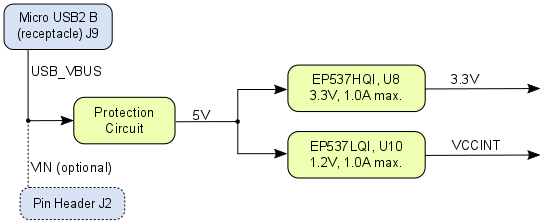
Figure 3: Power Distribution Diagram
| FPGA | Design | Typical Power, 25C ambient |
|---|---|---|
| Mircosemi SmartFusion2 FPGA SoC M2S010-VFG400 | Not configured | TBD* |
Table 9: Module power consumption
*TBD - To Be Determined.
Actual power consumption depends on the FPGA design and ambient temperature.
There is no specific or special power-on sequence, just one single power source is needed.
Parameter | Min | Max | Units | Reference document |
|---|---|---|---|---|
VIN supply voltage (5.0V nominal) | -0.3 | 6.0 | V | EP53A7HQI / EP53A7LQI datasheet |
| I/O Input voltage for FPGA I/O bank | -0.3 | 3.63 | V | Microsemi datasheet DS0128 |
Storage Temperature | -40 | +90 | °C | LED R6C-AL1M2VY/3T datasheet |
Table 10: Absolute maximum ratings
| Parameter | Min | Max | Units | Reference document |
|---|---|---|---|---|
| VIN supply voltage (5.0V nominal) | 4.75 | 5.25 | V | same as USB-VBUS specification |
| I/O Input voltage for FPGA I/O bank | 0 | 3.45 | V | Microsemi datasheet DS0128 |
| Operating temperature range | 0 | +70 | °C | Winbond datasheet W9864G6GT |
Table 11: Recommended operating conditions
| Please check Microsemi datasheet DS0128 for complete list of absolute maximum and recommended operating ratings for the FPGA device. |
Please note that two different units are used on the figures below, SI system millimeters (mm) and imperial system thousandths of an inch(mil). This is because of the 100mil pin headers used, see also explanation below. To convert mils to millimeters and vice versa use formula 100mil's = 2,54mm.
Board size: PCB 25mm × 61,5mm. Notice that some parts the are hanging slightly over the edge of the PCB like the the Micro USB2 B connector, which determine the total physical dimensions of the carrier board. Please download the assembly diagram for exact numbers.
PCB thickness: ca. 1.65mm
Highest part on the PCB without fitted headers and connectors is the Micro USB2 B connector, which has an approximately hight of 3 mm. Please download the step model for exact numbers.
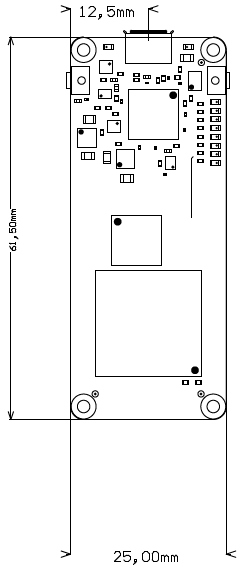
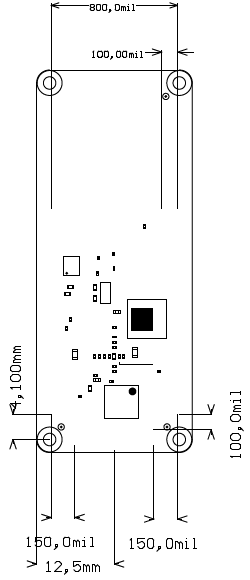
Figure 4: Module physical dimensions drawing
| Date | Revision | Notes | PCN | Documentation Link |
|---|---|---|---|---|
| - | 01 |
| - | TEM0001-01 |
Table 12: Module hardware revision history
Hardware revision number is printed on the PCB board together with the module model number separated by the dash.
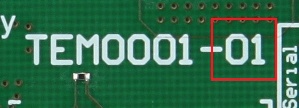
Figure 5: Module hardware revision number
| Date | Revision | Contributors | Description |
|---|---|---|---|
| |||
| v.33 | Antti Lukats |
| |
2018-04-17 | v.31 | Ali Naseri |
|
Table 13: Document change history